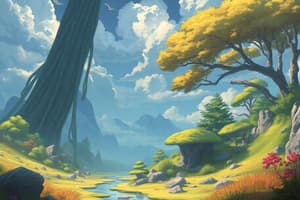Podcast
Questions and Answers
Which factor primarily characterizes a biome?
Which factor primarily characterizes a biome?
- Proximity to urban centers
- Large-scale dominant vegetation patterns (correct)
- Specific animal species
- Unique geological formations
An ecosystem is a smaller classification than a biome.
An ecosystem is a smaller classification than a biome.
True (A)
Which of the following best describes the primary factors determining a biome's characteristics?
Which of the following best describes the primary factors determining a biome's characteristics?
- Mean annual temperature and precipitation (correct)
- Latitude and longitude
- Soil composition and altitude
- Dominant animal species and water availability
Deserts and tundra biomes share which common climatic characteristic?
Deserts and tundra biomes share which common climatic characteristic?
The presence of grasslands, savannas, shrublands and woodlands is most dependent on what environmental factor?
The presence of grasslands, savannas, shrublands and woodlands is most dependent on what environmental factor?
Precipitation is an important factor that determines the presence of grasslands.
Precipitation is an important factor that determines the presence of grasslands.
Which of the following primarily delineates tropical seasonal and tropical rainforests?
Which of the following primarily delineates tropical seasonal and tropical rainforests?
What is an anthrome?
What is an anthrome?
Barren anthromes are most accurately described as:
Barren anthromes are most accurately described as:
Which of the following factors best describes the organization of an ecological system?
Which of the following factors best describes the organization of an ecological system?
What would a rainfed mosaic village contain?
What would a rainfed mosaic village contain?
What is a similarity between tundra and deserts?
What is a similarity between tundra and deserts?
The ecological system ______ has been disrupted by human's transformations of the planet
The ecological system ______ has been disrupted by human's transformations of the planet
What is a biome?
What is a biome?
What two abiotic variables are used to characterize biomes?
What two abiotic variables are used to characterize biomes?
Why were traditional biomes no longer accurate?
Why were traditional biomes no longer accurate?
Flashcards
What are biomes?
What are biomes?
Ecological system characterized by large-scale dominant vegetation patterns.
What are Anthromes?
What are Anthromes?
Ecological patterns created and sustained by interactions between humans and ecosystems.
Arctic/Alpine biome?
Arctic/Alpine biome?
Arctic and alpine biomes have cold temperatures with very little precipitation.
Cold Temperate biome?
Cold Temperate biome?
Signup and view all the flashcards
Warm Temperate biome
Warm Temperate biome
Signup and view all the flashcards
Tropical biome?
Tropical biome?
Signup and view all the flashcards
Deserts vs. Tundra
Deserts vs. Tundra
Signup and view all the flashcards
Grasslands/Savannas/Shrublands/Woodlands
Grasslands/Savannas/Shrublands/Woodlands
Signup and view all the flashcards
Broadleaf vs. rainforest
Broadleaf vs. rainforest
Signup and view all the flashcards
Urban Anthromes
Urban Anthromes
Signup and view all the flashcards
Agricultural Anthromes
Agricultural Anthromes
Signup and view all the flashcards
Rangeland Anthromes
Rangeland Anthromes
Signup and view all the flashcards
Forested Anthromes
Forested Anthromes
Signup and view all the flashcards
Wildland Anthromes
Wildland Anthromes
Signup and view all the flashcards
Study Notes
- An ecological system characterized by large-scale dominant vegetation patterns defines biomes.
- Habitats make up ecosystems, which in turn form a biome.
- Species distributions vary along a moisture gradient in locations such as the Siskiyou Mountains (OR) and the Santa Catalina Mountains (AZ).
Pattern of World Biomes
- The pattern correlates with mean annual temperature and precipitation.
- Arctic and alpine biomes have cold temperatures and very little precipitation.
- Cold temperate biomes are cooler than warm temperate and tropical biomes with a precipitation range of about 40-200 cm per year.
- Warm temperate biomes have precipitation up to 300 cm per year and mean annual temperatures between 2 and 18°C.
- Tropical biomes have a high range of precipitation and warm mean annual temperature.
- Tundra and deserts have have low precipitation.
- Grasslands, savannas, shrublands and woodlands depend upon temperature.
- Lower precipitation occurs in temperate and tropical forests.
- The existence of woodland or grassland depends on disturbances.
- Temperate forest and temperate rainforest presence depends upon precipitation.
- Tropical seasonal and tropical rainforests are delineated by precipitation.
Ecoregions of Eastern Temperate Deciduous Forests (Eastern US)
- Ecoregions include Piedmont, Northeastern Highlands, Northeastern Coastal Zone, Northern Allegheny Plateau, North Central Appalachians, Northern Piedmont, Blue Ridge, Ridge and Valley, Southwestern Appalachians, Central Appalachians, Western Allegheny Plateau, Interior Plateau, Acadian Plains and Hills, and Eastern Great Lakes Lowlands.
- The WWF has developed 14 biomes of the world.
Anthromes
- These are ecological patterns created by sustained interactions between humans and ecosystems.
- Types of anthropogenic biomes include dense settlements, villages, croplands, rangeland, forested, and wildlands.
- Anthromes include urban areas and dense settlements.
- Anthromes also include rice and irrigated villages, cropped and pastoral villages, pastoral and rainfed villages, and rainfed mosaic villages.
- Croplands consist of residential irrigated cropland, residential rainfed mosaic, populated irrigated cropland, populated rainfed cropland and remote croplands.
- Rangeland include residential, populated, and remote areas.
- Forests can be populated or remote.
- Wildlands are wild forests with sparse trees and barren land.
Global Human Population
- Anthromes contain 80% of the human population and cover about 77% of ice-free land.
- Urban anthromes cover less than 1% of the Earth’s ice-free land.
- Only 23% of the ice-free land is uninhabited.
- Cultivated anthromes with higher population densities account for 1/3 of Net Primary Production (NPP).
Studying That Suits You
Use AI to generate personalized quizzes and flashcards to suit your learning preferences.




